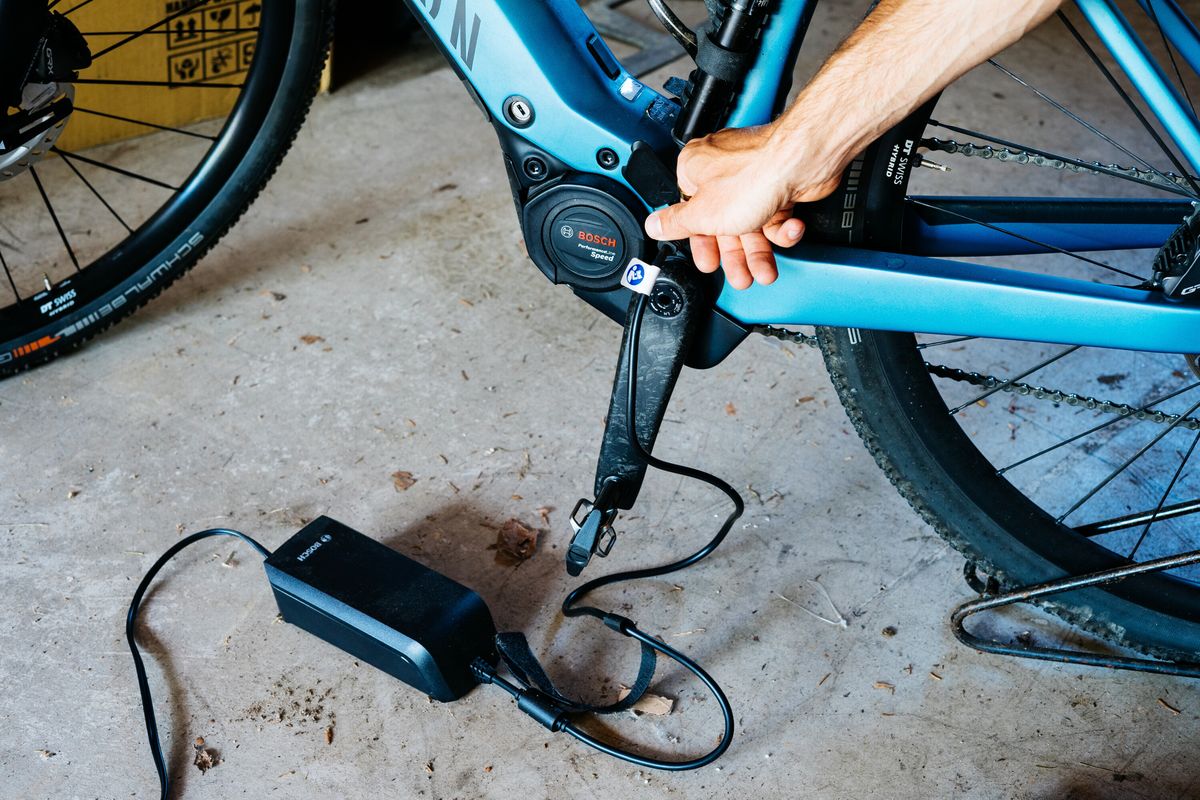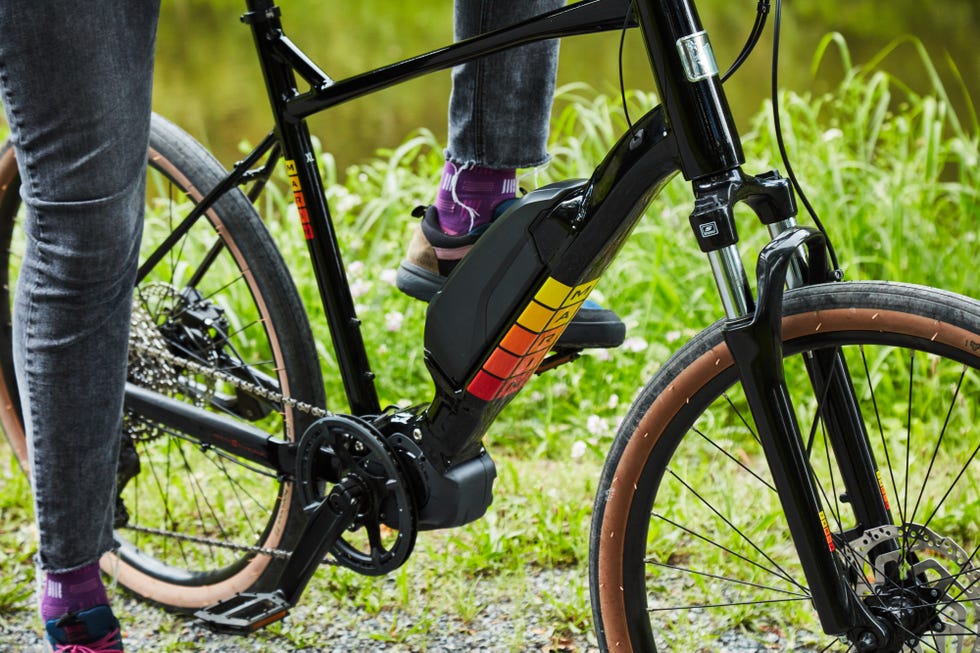If you bought a bike in the last year, chances are good it’s an e-bike. Electric bicycles are the fastest-growing type of bike in the U.S. today; in 2021 they surpassed road bikes as the third biggest category of bikes overall. E-bikes outsell electric cars, and for good reason. The lightweight electric motor on an e-bike gives a powerful boost to all kinds of riding, especially utility cycling like commuting and errands.
At the heart of that system is a powerful lithium-based battery. Taking proper care of that battery is key to safely getting the best range and long-term battery life. Here’s what you need to know about charging your e-bike battery.
Safe charging basics
You should charge your battery inside, on the proper charger, and with the motor system powered off, says Kunal Kapoor, senior manager for quality and compliance at Bosch, a leading supplier of e-bike motor systems. While e-bike motors, batteries, and wiring are weather-resistant, “chargers aren’t intended for outdoor use,” he notes.
Using the proper charger is primarily a safety issue. With a modern lithium battery, Kapoor continues, when the battery signals it’s ready to accept a charge, “the battery monitoring system in the charger makes sure that the temperatures inside the battery are optimum to receive the charge,” and shuts off if needed. An off-brand charger—even rated to the same output—doesn’t have all the features of that battery management system, so current can flow to the battery even if temperatures rise, which is a fire risk.
The risk of battery fires is low, but Kapoor recommends people not leave batteries unattended while charging. You can leave the battery on the bike to charge or take it off, as long as it’s not sitting on or near flammable stuff (like the spare gas can in the garage, for example). If you’re looking at lower-priced e-bikes with house-brand or unbranded motor and battery systems, make sure the battery and charger carry a UL 2849 certification stamp from Underwriters Laboratories. This is the industry-wide standard for safe electric systems and battery charging for e-bikes. Some bike shops won’t work on e-bikes with motor and battery systems that lack this stamp, citing fire risk when left overnight in the store.
How to optimize battery range and lifespan
Let’s start with some definitions. Range is essentially runtime: how long a battery will last on a single charge, expressed in miles of riding. Range, even on the same bike, will vary; a flat commute to the office with just a light backpack will see better range than a fully loaded uphill ride home from Costco. Most e-bikes today get between 25-75 miles of range, depending on these factors.
Lifespan is how many times a battery can be discharged and recharged before it starts to lose significant capacity. When capacity starts to dip, you won’t notice less power while riding, but you will see range start to shrink. A common lifespan benchmark for e-bike batteries is 500 “full” discharge/re-charge cycles (if you use half the battery capacity and recharge, that’s half a cycle), which works out to about three to five years of normal use before capacity begins to drop noticeably.
Even though battery range and lifespan aren’t the same thing, they are linked, and actions that reduce range will also, over time, shorten lifespan. A big culprit, Kapoor says, is running the motor hard, like leaving it in Boost or Turbo mode all the time, which means a ride of a given distance relies progressively more on motor power than at lower assist levels. You’ll run the battery through charging cycles more quickly, which will shorten its life.
A less-obvious factor that strains motors and batteries is pedal cadence. Most e-bike motors are optimized for efficiency around a 70-90 rpm pedaling cadence. You can lower efficiency by pedaling too fast (Bosch motors, for instance, max out at 100-120 rpm depending on the system). More common is sub-optimal efficiency from pedaling too slowly in a large gear. This is the same as “lugging the engine” in a car; whether gas or electric, the motor works harder. “Choose your gears wisely,” says Kapoor, to stay in that 70-90 rpm sweet spot.
Mistakes that kill your battery
When you buy a new e-bike, you should charge the battery to full before riding it because it’s likely been inactive for a while. But lithium batteries do not have “memory;” that is, they do not need to be fully discharged and fully recharged every time to hold their full capacity. In fact, it’s best if you don’t run a battery to zero, says Kapoor. “If you let the battery deplete completely, that may permanently damage it,” he says, and it will never recharge to its full original capacity.
If you’ll go a few weeks or more without riding the bike, store it (or at least the battery) in a dry, room-temperature space with the battery between 30-60 percent of full charge, says Kapoor. That’s the most stable level for long-term storage, and will lower the chance of a deep discharge that would damage your battery. Don’t leave your battery plugged in to the charger for long periods. It’s not necessary, and can create a short discharge/recharge cycle that will eventually reduce capacity. If you go long periods without riding the bike, check the battery charge monthly and partly recharge when it drops below 30 percent.
Lithium batteries are less affected by cold weather than other types of battery and you shouldn’t see reduced range while riding unless the temperatures are truly arctic. But researchers at the Department of Energy recently found storing lithium batteries below freezing for longer periods can damage part of the battery’s cathode, which will reduce its capacity. Lithium batteries also won’t charge effectively in cold temperatures. If you store your bike outside or in an unheated space and live in an area with sub-freezing temps, says Kapoor, bring the battery inside when not in use.
Also, keep your battery protected from extreme heat, like sitting next to a sunny window or a hot car. Excess heat can raise battery temperature enough to damage its components; in an extreme situation, it can contribute to what’s called thermal runaway, where a battery enters an unstable, uncontrollable self-heating state that can result in fire.
You don’t need to recharge after every ride. Topping off your battery sounds smart, but over time it will reduce capacity more quickly. If you get 50 miles of range from a charge and ride 10 miles a day, you only need to recharge every three to four days.
When it’s time to replace
Even if you take great care of a battery, over time it will lose capacity. You’ll notice this on your bike’s range estimate on the controller unit. Capacity is a primary indicator of the health of a battery, so if you notice your range dropping to 70 percent or less of what it was when your bike was new, that’s a sign to start planning a replacement. If your battery is less than two years old and is well under original capacity, it might be a warranty claim (terms vary by manufacturer).
If it’s not a warranty issue, the decision on when to replace is personal preference, says Kapoor. “If you got 50 miles (of range) out of the battery originally and let’s say now you get 40, I wouldn’t classify it as ‘end of life’ if you can live with that 40-mile range,” he says. A battery with reduced capacity should still be safe, Kapoor adds.
Always purchase a name-brand replacement for your battery. Just as batteries and chargers should be paired, batteries and motors are designed to work together. And, says Kapoor, never try to repair a damaged battery or let someone else do it. Despite guides that claim you can, this is not just corporate greed or legal butt-covering by manufacturers. While e-bike batteries are almost always made from standard 18650 cells that are widely used in various products (even electric cars), those cells have a variety of different chemistries, capacities, and amperages, and that’s before we even get into connecting a string of them and repackaging the battery in the housing. The slightest mistake in any of that increases fire risk. If you need a new battery, just buy one.
Dealers that sell your brand of bike can order you a direct replacement for that bike or motor brand. Costs vary depending on battery size and brand, but plan on spending $400-$800 for a new unit.
A dealer can also recycle your old one. A new program from Call 2 Recycle offers free e-bike battery recycling (paid for by bike and motor brands) through partner shops in almost every major city and many smaller ones. No participating dealers near you? Request an easy DIY shipping kit online.
Why recycle? Even a spent battery contains raw materials that can be re-made into fresh ones, at moderately less energy cost and less environmental damage than producing from virgin materials. Spent lithium batteries also have a fire risk in landfills and can leach toxic metals and other chemicals into the soil and air.
In case of fire
Though rare, battery fires do happen. If your battery gets hot to the touch while charging, unplug the charger from the wall immediately. If you can, put the battery in a metal container like a bucket (better yet, one filled with sand) away from anything flammable.
But if it’s not safe to handle, call 911 right away and tell the dispatcher that you have a lithium battery fire, which requires different firefighting methods than conventional fires. Don’t pour water on a battery fire; water and lithium react to produce hydrogen, which is highly flammable. A standard fire extinguisher may help, but in the event of a fire, special tools may be needed.














